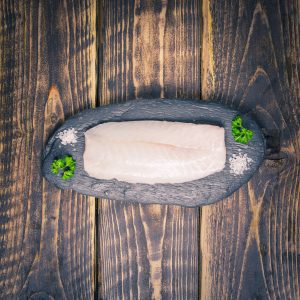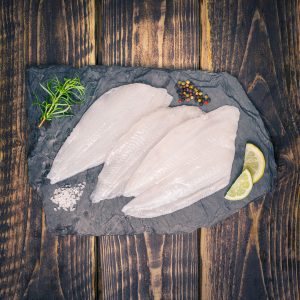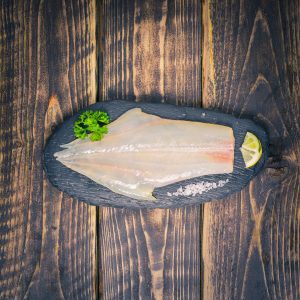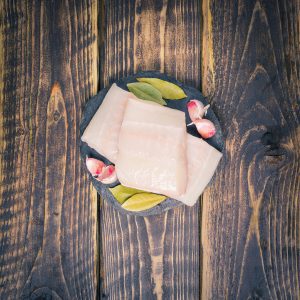A more accurate title for this post might be “What you need to poach a whole salmon” since poaching a salmon, with the right equipment, is a piece of cake. But you hopefully get the point.
And the end result of that point is extraordinary – a creature that yields seemingly endless amounts of soft, silky and sensational flesh that need little more than a fresh salad, a few wedges of lemon and boiled new potatoes – slathered in butter, naturally – to make it really sing. Once you’ve scoffed the best bits you’ll be left with oodles of leftovers that you can repurpose in a mousse, a pâté, croquettes or salmon burgers.
(For the avoidance of doubt, we’re not advocating poaching salmon in the sense of stealing it – if that’s what floats your boat then you should probably point your browser elsewhere.)
Whatever size of salmon you wish to poach, the one piece of culinary equipment you will need is a fish kettle. If you have a small fish then you can use a solid-based roasting tin, but for the purposes of this post we’re assuming you have a fish that’s at least 3.5kg – the minimum weight of whole salmon supplied by Fresh Fish Daily. Not even David Blaine could fit a 3.5kg salmon in a roasting tin without committing an act of violence, so you’re going to need a fish kettle.
A fish kettle does what it says on the tin: it’s a kettle for fish. You put your fish inside, add a poaching liquor – enough water to cover the fish plus some lemon juice and herbs, for example – put the lid on it then place the kettle on the hob and let it do its thing. Yes, it really is that simple.
If you’ve got money to burn then there’s a lot to like about the Italian-made Ruffoni fish kettle (Harrods, £545). For that price-tag you get a handmade piece of culinary art in hammered copper with a fancy brass handle shaped like an acorn. At 50cm in length, it will cope with a salmon that’s on the smaller side – probably one of our lightest specimens – and promises “uniform heat conduction and precise temperature control”. We’d expect that level of detail, but there you go.
On the downside, besides the alarming price the kettle isn’t dishwasher safe and, unless you’re a Russian oligarch, it will make the rest of your cookware look like something from the yard of Steptoe and Son.
For a fraction of the price you could do worse than KitchenCraft’s stainless-steel fish poacher (Wayfair, £44.99), which is 10cm longer than Ruffoni’s equivalent and can be used on all types of hob. We’ll steer clear of smutty jokes about what the extra length can offer and simply suggest that it will accommodate a bigger fish than the Ruffoni will. If you’re only going to poach smaller fish then KitchenCraft make cheaper options too.
A great alternative for those who have larger hobs is the aluminium fish kettle by Lacor (Amazon, £83.87), which measures a whopping 70cm – big enough for even the largest salmon. What with its size and heatproof handles, there’s more than a whiff of the professional chef about this product without the price-tag you might expect.
Once you’ve got yourself a fish kettle the door will open on poaching not just salmon but any whole fish whatsoever – sea bream, sea bass or rainbow trout for example. Besides the simplicity of the method, poaching is also a hugely healthy way to prepare fish, using zero fat and – when done correctly, we hasten to add – resulting in wonderfully soft, easy-to-digest flesh.
How you flavour your poaching liquid – or court bouillon (which translates as “short broth”) to give it its cheffy name – is really up to personal preference. Basic ingredients include water, white wine, salt, black pepper and herbs such as thyme or bay. You might want to add fennel, star anise, tarragon or whatever else takes your fancy – the only way to find out what you like is trial and error.
Bring the court bouillon to a simmer for anything up to 30 minutes before carefully adding the fish. Don’t allow the liquid to boil vigorously – a gentle simmer is ideal.
The length of time it takes to poach a whole salmon depends on the weight of the fish, but we’d recommend a minimum of 30 minutes for a 3.5kg salmon. While the fish is cooking you can get on with preparing the rest of the meal.
To check the salmon is cooked, insert the tip of a sharp knife into the thickest part of the fish – if it’s translucent then give it a little more time; if it’s done the flesh will be a light pink colour.
Your fish kettle will have an internal tray with hooks at both ends, so carefully use these to lift the salmon out of the court bouillon and place it on an appropriately sized dish or plate.
How you serve it is, once again, a matter of preference, but we’d suggest placing the whole fish in the centre of the dining table before cutting it into portions every time. It makes for a great piece of food theatre and will get your diners salivating.
So there you have it: how to poach a whole salmon.
There’s only one more thing to say, and that’s make sure you serve a Scottish salmon – they’re the best in the world, bar none.

















